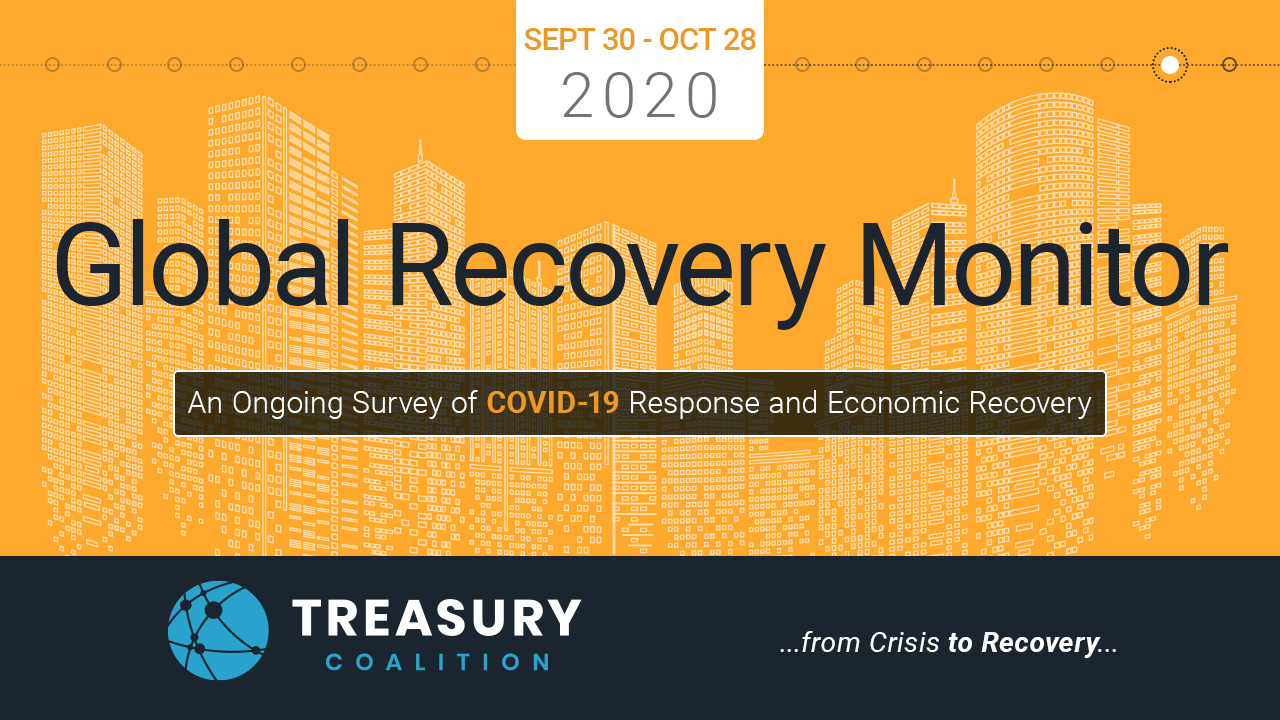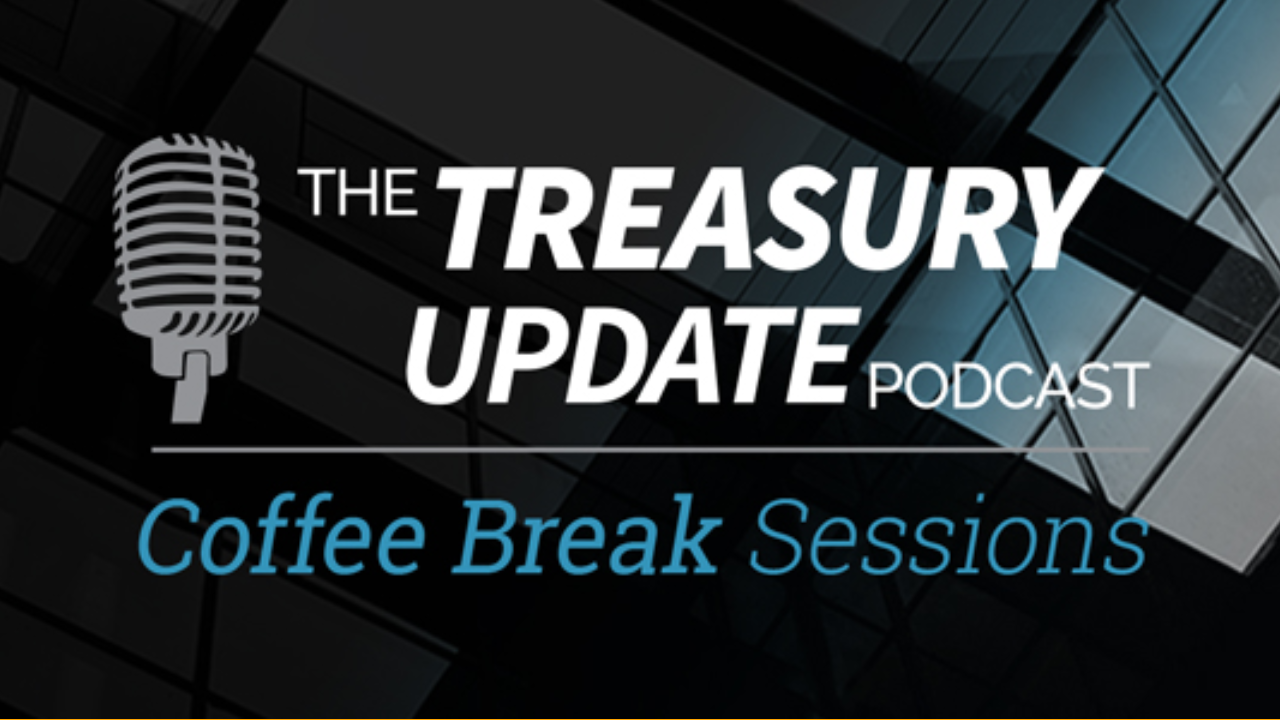
Session 23
Coffee Break Session:
What Is Open Treasury?
What is open treasury? Coffee Break Session Host Alexa Cook catches up with Strategic Treasurer’s Managing Partner Craig Jeffery to discuss the foundational elements of open treasury. They explore the purpose behind it, how it can be leveraged, and why it is important. Listen in to learn a bit about open treasury.
Host:
Alexa Cook, Strategic Treasurer


Speaker:
Craig Jeffery, Strategic Treasurer


Episode Transcription - CBS Episode 23: What is Open Treasury
Alexa:
Hey guys, welcome to the Treasury Update Podcast, Coffee Break Session. The show where we cover foundational Treasury topics and questions in about the same amount of time it takes you to drink your coffee. This is your host Alexa, and today I am joined with Craig Jeffrey, Managing Partner of Strategic Treasurer. Welcome back, Craig.
Craig Jeffery:
Hey Alexa, it’s good to be here again.
Alexa:
Yeah. Thanks for joining us. So today we’re going to dive right in and talk about open Treasury. So Craig, what is open Treasury?
Craig Jeffery:
Yeah, for a brief definition would be that it’s enabling Treasury development or technology development in Treasury to be more democratized or spread out. So, it’s open versus closed, open systems versus closed that more providers can develop, rather than just the single provider for whatever the Treasury solution is. So, it allows open API use, which is what I said earlier, just a few sentences ago, it means a broader development is possible, democratization development, since third-party developers can build applications that interface with your banks, your accounting system, your Treasury system, your external sets of data.
Alexa:
Okay. Why is this important?
Craig Jeffery:
There’s multiple reasons why it’s important. A couple of things would be the growth of data. We see data growing 40 to 60% on a compound annual growth rate per year. There’s an increase in expectations on what we do. And this drives us to the conclusion that we need faster development. And that means democratizing it, that it’s developed in different areas to create innovation. And open Treasury, this development allows the extension of this development across multiple providers. So multiple providers can build connections to other systems. And this allows for Treasury to realize an integrated best of breed solution suite, as opposed to, “Hey, I’m just going to go to single solution and hope for the best and say, we hope we can get 60%, 70% of what we do with best of breed providers.” Because integration is a challenge.
Craig Jeffery:
If you talk to ERP vendors, they like to refer to other providers as point solutions or third-party providers. Treasury vendors, whether it’s banks, TMS or other platforms, they’ll refer to themselves as specialist and best of breed. But, open Treasury requires a core platform that can be extended, and so this provides a setting for integrated best of breed. And that’s why it’s important because it allows Treasury to realize the technology growth and developments that are really hard in closed environments. They’ve never been able to develop as fast in closed environments as we’re seeing in the open environment.
Alexa:
Okay. That makes sense. What’s maybe be an example of open Treasury or what you just described?
Craig Jeffery:
Well, we’ve been using open Treasury. The more common term people use is open banking, as banks have sought to open up their activity, whether it’s information or transactions, they’re trying to open up their challenging backend systems with a great front end system that allows you to connect and PSD2, the Payment Services Directive 2, not only supports this concept, but enforced it through regulations to support third-party development. Technology developers doing that through the use of open API. So if there’s such a thing as open banking for banks, there’s such a thing as open Treasury for corporate treasures.
Alexa:
Okay. I know a little bit earlier, I think you said open APIs. So why are we calling them open APIs instead of just APIs?
Craig Jeffery:
Yeah. Now you warned me that this is supposed to be a quick session, but I’ll try to answer that accurately and briefly. So I’ll give you something short here. So APIs, application programming interfaces, have existed for a long time, but you hear more open APIs now. And I’ll just set it up this way as, if you use some of the, I’ll just call them older API processes or methods, you may have web services utilities. Let’s say you have two cloud providers and you want to connect them and you might be able to connect them through web services utilities. There’s more setup, there’s more care and feeding, but they are APIs. And so what this means when you set that up is that you have to have a place to house your web services for both systems, cloud provider one and cloud provider two.
Craig Jeffery:
So you have a web services utility maybe sitting inside or in another cloud provided area to pull data down, to move it over to the second web services utility, which may be sitting inside your organization or in another cloud provided service. And then it will move that data up into the second cloud system. So here you have four access points and one, two, three handoffs to go one direction. Then when it goes back round trip, there’s three more handoffs and four points. So it’s heavier set up. There’s more care and feeding. But when we look at an open system, it means we can have the API talk to another system directly. So they’ll connect between cloud one and cloud two, for example, that go directly, there won’t be these waystations or staging points. You can make them have staging points, but the design is typically direct.
Alexa:
So why would Treasury then care about open Treasury and why is it important to Treasury?
Craig Jeffery:
Well, the development of tech in Treasury matters a lot because of growing data, growing expectations, the risk mindset. And this is essential because we’re charged with knowing more, doing more with data, running better analysis. So open banking and open Treasury are providing a faster development cycle. The cycle times are reduced and that does and can extend our ability to manage these processes and data significantly more efficiently with a lot less friction than ever before. Any new tech you get needs to support open Treasury, open banking, whatever you prefer. It’s a connected world and you need the control and ease of open API. So open APIs are very secure, but many people find it easier to set up, the learning curve is shortened and it provides significant values and it fosters this environment of innovation to address all these challenges that we have a hard time addressing and all the new challenges that are coming up.
Alexa:
So I’m going to do a quick recap of everything that we’ve covered starting with what is open Treasury. So that’s really the feature that is enabling Treasury tech developers to be more spread out and allows more providers to get their hands in the pot and work to develop Treasury technology. And this is important really because of the growth of the data. That’s the main driver behind it all, which is increasing the expectations in what we’re doing and that demand for the need of faster development, which is then allowing an integrated best of breed suite. And so Treasury is then able to realize that the development of those open environments. And then Treasury should really care about this because like what I said before that development of the tech and Treasury is going to matter because we want to know more and do more with that data constantly and the open data and open treasury is allowing for more to be done with more efficiency. I don’t know if I covered everything or if you want to add anything to that, Craig?
Craig Jeffery:
Yeah. You covered what my responses were very well. I would say I want to emphasize one other point, which was a little more muted in what I said. It’s if you’re getting new tech, you need to make sure that your tech stack, your tech elements, support open APIs and open Treasury. This is so important because you’re buying or procuring different services, different functionality. It has to address the organization going forward, and this includes open Treasury. That has to be one of the essentials. It’s not an optional or a nice to have. It is an essential for every Treasury area. And this might be easier for smaller organizations too, who don’t have as much hardware and data investment in some of the older tech.
Alexa:
Okay, well, thank you for covering that with me today, Craig, and to all of our listeners, make sure you tune back in every first and third Thursday of the month for a new episode. And as always, we love hearing from you. So please make sure to reach out or connect with us at podcast@strategictreasurer.com. Thanks again, Craig. It was a pleasure having you.
Craig Jeffery:
Thank you, Alexa, take care.
OUTRO:
This podcast is provided for informational purposes only and statements made by Strategic Treasurer, LLC on this podcast are not intended as legal, business, consulting or tax advice. For more information, visit and bookmark strategictreasurer.com.
Global Recovery Monitor
Join us in our ongoing market research throughout the coronavirus crisis. Take this 5-minute survey and receive early access to the results report.
Coffee Break Sessions – A Treasury Update Podcast Series
A part of the Treasury Update Podcast, Coffee Break Sessions are 6-12 minute bite-size episodes covering foundational topics and core treasury issues in about the same amount of time it takes you to drink your coffee. The show episodes are released every first and third Thursday of the month with Special Host and Treasury Consultant Alexa Cook of Strategic Treasurer.




